社会语言学课程教案
日语社会语言学 教学大纲

日语社会语言学教学大纲日语社会语言学教学大纲引言日语作为一门外语,不仅仅是一种语言工具,更是一种文化的载体。
在日语教学中,除了传授基础的语法和词汇知识外,了解社会语言学的概念和原理也是非常重要的。
本文将探讨日语社会语言学在教学中的应用,并提出一份日语社会语言学教学大纲,以帮助学生更好地理解和运用日语。
第一部分:社会语言学概述社会语言学是研究语言和社会之间相互关系的学科,它探讨语言在社会环境中的变化和运用。
在日语教学中,社会语言学的概念和原理可以帮助学生更好地理解日语的语用规则和交际方式。
第二部分:日语教学中的社会语言学应用2.1 社会语言学在语言教学中的重要性社会语言学的应用可以帮助学生更好地理解日语的语境和语用规则。
通过学习社会语言学,学生可以更准确地理解日语中的礼貌用语、敬语表达和言语行为规范等。
这些都是日语交际中不可或缺的要素,对于学生的语言运用能力和交际能力的提升至关重要。
2.2 社会语言学在日语教学中的实践在日语教学中,可以通过以下几个方面来应用社会语言学的概念和原理:2.2.1 社会语言学案例分析通过分析真实的日语交际案例,学生可以更好地了解日语中的语境和语用规则。
教师可以选择一些日常生活中的对话片段,引导学生分析其中的语言行为和交际意图。
2.2.2 社会语言学讨论课教师可以组织社会语言学讨论课,让学生就特定的社会语言学问题进行讨论和思考。
例如,讨论日语中的敬语用法,学生可以分享自己的观察和经验,并进行互动交流,从而加深对敬语的理解。
2.2.3 社会语言学实地考察组织学生进行社会语言学实地考察,让他们亲身体验日语在真实社会环境中的运用。
例如,学生可以前往日本餐厅进行点餐,观察和体验日本人的用语和礼仪规范。
第三部分:日语社会语言学教学大纲为了更好地引导日语教学中的社会语言学应用,以下是一份日语社会语言学教学大纲的建议:3.1 社会语言学基础知识介绍社会语言学的基本概念和原理,包括语境、语用规则、言语行为等。
社会语言学教案

A Brief Introduction to SociolinguisticsLecturer: Jia junminSchool of Foreign LanguagesTianshui Normal University2004. 01Do not bring your ears onlyBring your mouth alsoInto the classroomPurposeThis course aims at providing English-major students with a sociocultural perspective to view language issues and help them understand the complicated interaction of language with culture and society.Basic Requirements1.Critical reading of the suggested reading materials is essential to theunderstanding of the topic under discussion;2.Attendance is required;3.Active participation is greatly encouraged. Students are required to participate ingroup discussions;4.Exercises and term paper should be handed in on time.Assessment1.Attendance: 10%.2.Participation: 15%3.Term-paper: 25%4.Final test: 50%Syllabus1 An overview of Sociolinguistics2 Language, dialects and varieties3 Style and registers4 Language contact—pidgins and Creoles5 Diglossia and code-switching6 Societal Multilingualism7 Ethnography of speaking and the structure of conversation8 Language and gender9 Language and culture10 Final test.Unit OneAn Overview of SociolinguisticsⅠResearch Background1.Formal LinguisticsToday, most linguists agree that the knowledge the speakers have of the language or languages they speak is knowledge of something quite abstract. It is knowledge of rules and principles and of the ways of saying and doing things with sounds, words, and sentences. It is knowing what is in the language and what is not; it is knowing the possibilities the language offers and what is impossible. This knowledge explains how it is we can understand sentences we have not heard before and reject others as being ungrammatical.Confronted with the task of trying to describe the grammar of a language like English, many linguists follow the approach which is associated with Noam Chomsky(Noam1928-American linguist ). Chomsky has argued that, in order to make meaningful discoveries about language, linguists must try to distinguish between what is important and what is unimportant about language and linguistic behavior. The important matters, sometimes referred to as language universals, concerns the learnability of all languages, the characteristics they share, and the rules and principles that speakers apparently follow in constructing and interpreting sentences; the less important matters have to do with how individual speakers use specific utterances in a variety of ways as they find themselves in this situation or that situation.Chomsky has distinguished between what he has called competence and performance. He claims that it is the linguists‟ task to characterize what speakers know about their language, i.e., their competence, not what they do with their language, i.e., their performance. According to him, performance is influenced by memory limitations, distractions, shifts of attention and interest, and error (random or characteristic) in applying his knowledge of the language in actual performance.Chomsky aims to describe the idealized competence of an idealized monolingual in an idealized monovariety speech community. In his view, linguistic study is an autonomous, self-sufficient system. For him, the existence of variation in languages imply confuses, diverting the linguists‟attention from the wonderful abstract system that separates human language from other communication systems.2. The problem of VariationThe language we use in everyday living is remarkably varied. Speakers make constant use of the many different possibilities offered to them. No one speaks thesame way all the time, and single-style speakers will not be found.Factors to lead to variation of language: regionagesocial classeducationgenderoccasion, ethnicityExample: be sackedbe fired辞退,解雇,解聘,丢饭碗,下课,下岗,失业炒鱿鱼,卷铺盖A recognition of variation implies that we must recognize that a language is notjust some kind of abstract object of study. It is also something that people use. It is not surprising therefore that some linguists‟doubt the possible value of a linguistics that deliberately separates itself from any concern with the use, and the uses, of language. Many sociolinguists have argued that an asocial linguistics is scarcely worthwhile and that meaningful insights into language can be gained only if such matters as use and variation are included as part of the data which must be explained in an adequate linguistic theory; an adequate theory of language must have something to say about the uses of language.As we will see, there is considerable variation in the speech of any one individual, but there are also definite bounds/limits to that variation: no individual is free to do so far as language is concerned. The variation you are permitted to use has limits and these limits can be described with considerable accuracy. That is, there are group norms so far as variation is concerned.ⅡResearch Scope1.Definition (See book, Page 3)2.Sociolinguists are interested in the relations between language and society.Four possible relations between language and society.(See book, Page 79)Assignments:Thought Questions:1.What evidence does the writer mention for the effects of social structure on language?2.What evidence could you give for and against the “no relationship ”position?3.Sociolinguistics and the Sociology of Language (See book, PP5-7)(micro- Sociolinguistics) (macro- Sociolinguistics)The former is concerned with investigating the relationships between language and society with the goal being a better understanding of the structure of language and ofhow languages function in communication: the study of language in relation to society: the latter is concerned with trying to discover how social structure can be better understood through the study of language, e.g., how certain linguistic features serve to characterize particular social arrangements: the study of society in relation to language.ⅢResearch MethodologyThe approach to sociolinguistics is that it should encompass everything from considering …who speaks (or writes) what language (or what language variety) to whom and when and to what end‟.1.clandestine / / recording2.sociolinguistic interview (See book, PP10-12)3.questionnaireWhatever sociolinguistics is, any conclusions we come to must be solidly based on evidence. As an empirical science, it must be founded on an adequate database. The data is drawn from a wide variety of sources. These include censuses, documents, surveys, and interview. Some data require the investigator to observe “naturally occurring”linguistic events, e.g., conversations; others require the use of various elicitation to gain access to the data we require.ⅣSociolinguistics and Related disciplinesparent disciplines: linguistics and sociologyrelated disciplines: anthropology, psychology, gender studies, public policy management, political science and history.Unit TwoLanguage, Dialects, and VarietiesEach language exists in a number of varieties and is in one sense the sum of those varieties.ⅠLanguage and Dialects1.Folk conceptualization of dialectsMost speakers can give a name to whatever it is they speak. But how do we decide what is language and what is a dialect of a language? What criteria can you possibly use to determine that, whereas variety x is a language, variety y is only a dialect of a language? What are the essential differences between a language and a dialect?For ordinary people, a dialect is almost certainly no more than a local non-prestigious (therefore powerless) variety of a real language. It is often equivalent to nonstandard or even substandard, connoting a various degree of inferiority.Thought question: Do you speak the dialect of your hometown, if you have one, in the classroom? Why or why not?Language can be used to refer either to a single linguistic norm or to a group of related norms, and dialect to refer to one of the norms. As a result, the standard is often not called a dialect at all, but is regarded as the language itself.2.Regional Dialect and Social Dialect3.Case studies①Hindi-Urdu situation(北印度语,乌尔都语)Hindi and Urdu are the same language, but one in which certain differences are becoming more and more magnified(popular) for political and religious reasons. Hindi is written left to right in the Devanagari / / (梵文字母)script, whereas Urdu is written right to left in the Arabic-Persian script.Whereas Hindi draws on Sanskrit(梵文)for its borrowings, Urdu draws on Arabic and Persian sources. Large religious differences make much of small linguistic differences.②Yugoslavia situationYugoslavia, a country now brutally dismembered with the instruments of ethnicity, language and religion. Within the old Yugoslavia, Serbs(塞尔维亚人/语)and Croats (克罗地亚人/语)failed to agree on most things and after the death of President Tito the country, slowly at first and then even more rapidly later, fell into a fatal divisiveness(分裂). Slovenians斯洛文尼亚人/语)and Macedonians (马其顿)excised (separate)themselves most easily, but the Serbs and the Croats were not so lucky. Linguistically, Serbo-Croatian is a single south Slav(斯拉夫) language but one used by two groups of people, the Serbs and Croats, with somewhat different backgrounds.There are Serbian and Croatian varieties of Serbo-Croatian. The actual differences between the two varieties mainly involve different preferences in vocabulary rather than differences in pronunciation or grammar. That is, Serbs and Croats often use different words for the same concepts. The varieties are written in different scripts (Roman for Croatian and Cyrillic(古代斯拉夫语字母)for Serbian), which also reflect the different religious loyalties of Croats and Serbs (the western and eastern rites of Catholicism). As conflict grew, differences became more and more important and the country and the language split apart.③Scandinavia(斯堪的纳维亚半岛:瑞典、挪威、丹麦、冰岛的泛称)situationDanish, Norwegian (actually two varieties), and Swedish are recognized as different languages, yet if you speak any one of them you will experiencelittle difficulty in communication. Danish and Norwegian share much vocabulary but differ considerably in pronunciation. In contract, there are considerable vocabulary differences between Swedish and Norwegian but they are similar in pronunciation. Both Danes and Swedes claim good understanding of Norwegian. However, Danes claim to comprehend Norwegians better than Norwegians claim to comprehend Danes. The poorest mutual comprehension is between Danes and Swedes. Danes understand Swedes better than the Swedes understand Danes. The best understanding is between Norwegians and Swedes. These differences in mutual intelligibility reflect power relationships. Denmark long dominated Norway, and Sweden is today the most influential country in the region and Denmark the least powerful.④Chinese situationA shared writing system and a strong tradition of political, social, and culturalunity form essential parts of their definition of language.⑤European ContinentIt is still possible to travel long distances and, by making only small changes in speech from location to location, continue to communicate with the inhabitants. (You might have to travel somewhat slowly, however, because of the necessary learning that would be involved.) It has been said that at one time a person could travel from the south of Italy to the north of France in this manner. It is quite clear that such a person began the journey speaking one language and ended in speaking something entirely different. Such a situation is often referred to as a dialect continuum.The hardening of political boundaries in the modern world led to the hardening of language boundaries. Various pressures --- political, social, cultural, and educational serve to harden current state boundaries.⑥Classical ArabicThe literary and colloquial forms of Arabic used in Iraq, Morocco and Egypt are grammatically quite separate, yet only one language is recognized in each case.ⅡCriteria in the language-dialect distinction1. Standardization refers to the process by which a language has been codified in some way. That process usually involves the development of such things as grammars, spelling books, and dictionaries, and possibly a literature. E.g., Wycliffe‟s and Luther‟s translations of the Bible into English and German, Caxton‟s(1422-1491 英国第一位印刷家)establishment of printing in England, and Dr Johnson‟s dictionary of English published in 1755.(What events can be related to the standardization process of Chinese?)①Problems of standardizationSelection of the norm may prove difficult because choosing one variety as a norm means favoring those who speak that variety. It also diminishes (decrease) all the other varieties and possible competing norms. The chosen norm inevitably becomes associated with power and the rejected with lack of power. Not surprisingly, it usually happens that a variety associated with an elite / / is chosen.②Functions of standardization processa.It unifies individuals and groups within a larger community while at the sametime separating the community that results from other communities.Therefore, it can be employed to reflect and symbolize some kind of identity: regional, social, ethnic, or religious.b. A standardized variety can also be used to give prestige to speakers. It cantherefore serve as a kind of goal for those who have somewhat different norms.③standardization is also an ongoing matter.2. Vitality refers to the existence of a living community of speakers. This criterion can be used to distinguish languages that are …alive‟from those that are …dead‟. Once a language dies it is gone for all time. A language can remain a considerable force even after it is dead, that is, even after it is no longer spoken as anyone‟s first language. Classical Greek and Latin still have considerable prestige in the western world. Sanskrit (梵语)is important to speakers of Hindi(北印度语). Classical Arabic provides a unifying force in the Islamic world; and Classical Chinese has considerably influenced not only modern Chinese but also Japanese and Korean.3. Historicity / / (史实性)refers to the fact that a particular group of people finds a sense of identity through using a particular language: it belongs to them. Social, political, religious, or ethnic ties may also be important for the group, but the bond provided by a common language may prove to be the strongest tie of all.4.Autonomy is really one of feeling. A language must be felt by its speakers to bedifferent from other languages. However, this is a very subjective criterion. Some speakers of Black English maintain that their language is not a variety of English but is a separate language in its own right. In contrast, speakers of Cantonese and Mandarin deny that they speak different languages.5. Reduction refers to the fact that a particular variety may be regarded as a sub-variety /(次变体,亚变体)rather than as an independent entity. Speakers of Cockney (伦敦方言)will almost certainly say that they speak a variety of English, admit that they are not representative speakers of English.6. Mixture refers to feelings speakers have about the …purity ‟ of the variety they speak. This criterion appears to be more important to speakers of some languages than of others, more important to speakers of French and German than to speakers of English.7. De facto(事实)norms refer to the feeling that many speakers have that there are both …good‟ speakers and …poor‟ speakers and the good speakers represent the norms of proper usage. Standards must not only be established, but they must also be observed. Concern with the norms of linguistic behavior, …linguistic purism‟, may become very important among specific segments of society. For example, so far as English is concerned, there is a very profitable industry devoted to telling people how they should behave linguistically, what is …correct‟ to say, what to avoid saying, and so on.Unit ThreeStyles and RegistersStyle(语体)refers to the formality of speech. We may try to relate the level of formality chosen to a variety of factors: the kind of occasion (setting); the various social, age, and other differences between the participants; the particular task; the emotional involvement. It is possible to show that native speakers of all languages control a range of stylistic varieties.It is also quite possible to predict the stylistic features that a native speaker will tend to employ on certain occasions.Registers(语域)are sets of language items associated with discrete occupational or social groups. For example, surgeons, airline pilots, bank managers, sales clerks, jazz fans, netizens. People participating in recurrent(循环的)communication situations tend to develop similar vocabularies, similar features of intonation, and characteristic bits of syntax and phonology that they use in these situations, special terms for recurrent objects and events.Functions: 1. facilitate speedy communication2. establish feelings of rapport.(亲善,和谐)Differences between dialect and register:Dialect (…dialectal variety‟) Register (…diatypic variety‟)---variety according to the user ---variety according to the useA dialect is A register iswhat you speak (habitually) what you are speaking (at one time) determined by who you are determined by what you are doing (socio-region of origin and /or adoption) (nature of social activity being engaged in) and andexpressing diversity of social structure expressing diversity of social process (patterns of social hierarchy) (social division of labor)so in principle dialects are: so in principle registers are:different ways of saying the same ways of saying different things and tend to thing and tend to differ in: differ in:phonetics, phonology, lexicogrammar semantics(and hence in lexicogrammar, but not in semantics and sometimes phonology, as realizationof this)Typical instances: Typical instancesSubcultural varieties occupational varieties(standard/nonstandard) (technical, semi-technical)Hudson (1996: 46) says: “Your dialect shows who you are while your registers shows what you are doing.”e.g. sentence style registerWe obtained some sodium chloride. formal technical (氯化纳)We got some sodium chloride. informal technicalWe got some salt. informal non-technicalUnit FourLanguage Contact—Pidgins and CreolesⅠ. Lingua franca 混合语,共用语People who speak different languages who are forced into contact with each other must find some way of communicating, a lingua franca. In 1953, UNESCO defined a lingua franca as …a language which is used habitually by people whose mother tongues are different in order to facilitate communication between them.‟A variety of other terms can be found: a trade language, a contact language, an international language, a global language, and an auxiliary language.Ⅱ. Pidgins and Creoles1. Origins of pidgins and creolesA pidgin is a language with no native speakers: it is no one‟s first language but is a contact language. That is, it is the product of a multilingual situation in which those who wish to communicate must find a simple language system that will enable them to do so. Very often too that situation is one in which there is an imbalance of power among the languages as the speakers of one language dominate the speakers of the other languages economically and socially. A pidgin is therefore sometimes regarded as a …reduced‟ variety of a …normal ‟ language, with simplification of the grammar and vocabulary of that language, considerable phonological variation, and an admixture of local vocabulary to meet the special needs of the contact group.Holm defines a pidgin as:A reduced language that results from extended contact between groups of people with no language in common; it evolves(develops) when they need some means of verbal communication, perhaps for trade, but no group learns the native language of any other group for social reasons that may include lack of trust or of close contact. Creole is often defined as a pidgin that has become the first language of a new generation of speakers.Pidginization generally involves some kind of simplification.2. Features of pidgin and creolesEach pidgin or Creole is a well organized linguistic system.1)The sounds of a pidgin are likely to be fewer and less complicatedTok Pisin( New Guinea Pidgin ) makes use of only five basic vowels and also has fewer consonants than English. The necessary vowel and consonant distinctions are not present.English: ship sheepTop Pisin: sip sipsip2) In pidgins and Creoles there is likely to be a complete lack of inflection in nouns, pronouns, verbs, and adjectives. Nouns are not marked for number and gender, and verbs lack tense markers. Pronouns will not be distinguished for case. So there will beno I-me, he-him alternation.Me ---- I me we ---- mipela ( I and others) / yumi( I and you) 3) Syntax is likely to be simplified in clausal structure.The development of embedded clauses, e.g. of relative clauses, is one characteristic of the process of embedded clauses.4) V ocabulary has a great similarities to that of the standard language.talk --- talk talktalk (chatter) looklook (stare)crycry --- cry continually san --- sun sansan --- sand3 Pidgin to Creole and BeyondNot every pidgin eventually becomes a Creole, i.e., undergoes the process of creolization. In fact, very few do.Creolization occurs only when a pidgin for some reason becomes the variety of language that children must use in situations in which use of a “full”language is effectively denied them.Tok Pisin as a Creole1)people speak Creoles faster than pidgins and they do not speak them word byword. Consequently, process of assimilation and reduction can be seen at work in Tok Pisin:mamblomi (assimilation) bilong-blo (reduction)2)Expansion of vocabulary resources: new shorter words are formed.3)Creole continuumAn English-based Creole can develop a number of varieties when it is in contact with Standard English. As the range of these varieties increases, Standard English may more and more influence them in a process of decreolization so that some varieties will come to resemble Standard English.Unit FiveDiglossia and Code-SwitchingWe may refer to a language or a variety of a language as a code. The term is useful because it is neutral. Terms like dialect, style, standard language are inclined to arouse emotions. In contrast, the term code can be used to refer to any kind of system that two or more people employ for communication.Ⅰ.Diglossia(双语体现象)1.Definition:A diglossic situation exists in a society when it has two distinct codes which show clear functional separation; that is, one code is employed in one set of circumstances and the other in an entirely different set.2.Features①A key defining characteristic of diglossia is that the two varieties are kept quite apart in their functions. One is used in one set of circumstances and the other in an entirely different set. For example, the H varieties may be used for delivering sermons and formal lectures, especially in a parliament or legislative body, for giving political speeches, for broadcasting the news on radio and television, and for writing poetry, fine literature, and editorials in newspapers. In contrast, the L varieties may be used in giving instructions to workers in low-prestige occupations or to household servants, in conversations with familiars, in …soap operas‟ and popular programs on the radio. You don‟t use an H variety in circumstances calling for an L variety, e.g., for addressing a servant; nor do you usually use an H variety when an L is called for, e.g., for writing a …serious ‟ work of literature.②The H variety is the prestige variety; the L variety lacks prestige. In fact, there may be so little prestige attached to the L variety that people may even deny that they know it although they may be observed to use it for more frequently than the H variety.③All children learn the L variety. Some may concurrently learn the H variety, butmany don not learn it at all. The H variety is likely to be learned in some kind of formal setting, e.g., in classrooms. To that extent, the H variety is …taught‟, where the L variety is …learned‟.④The L variety often shows a tendency to borrow learned words from the H variety,particularly when speakers try to use the L variety in more formal way. The result is a certain admixture of H vocabulary into the L.ⅡPower and SolidarityPower requires some kind of asymmetrical relationship between entities: one has more of something that is important, e.g. status, money, influence, etc., than the other or others.Solidarity is a feeling of equality that people have with one another. They have a common interest around which they will bond. A feeling of solidarity can lead people to preserve a local dialect or an endangered language to resist power, or to insist on independence.ⅢBilingualism (see PP44-48)ⅣCode-Switching1.DefinitionWhen two or more languages exist in a community, speakers frequently switch from one language to another. This phenomenon is known as code-switch. As Gal (Wardhaugh, 2000:100) says, …code-switching is a conversational strategy used to establish, cross or destroy group boundaries; to create, evoke or change interpersonal relations with their rights and obligations‟.2.Types of Code-Switching①Situational code-switching occurs when the languages used change according to the situations in which the conversants find themselves: they speak one language in one situation and another in a different one. No topic changes is involved. Example: for a …typical‟ child growing up in Singapore, he will tend to speak Hokkien with parents and informal Singapore English with siblings. Conversation with friends will be in Hokkien or informal Singapore English. The language of education will be the formal variety of Singapore English and Mandarin. Any religious practices will be conducted in the formal variety of Singapore English if the family is Christian, but in Hokkien if Buddhist or Taoist. The language of government employment will be formal Singapore English but some Mandarin will be used from time to time; however, shopping will be carried on in Hokkien, informal Singapore English, and the …bazaar‟variety of Malay used throughout the region.②Metaphorical code-switching occurs when a change of topic requires a change in the language used. Some topics may be discussed in either code, but the choice of code adds a distinct flavor to what is said about the topic. The choice encodes certain social values.Example by Jan-Petter Blom and John Gumperz out of their research in a town in northern Norway.Bokmal --- standard (H) Ranamal --- (H)In the course of a morning spent at the community administration office, we noticed that clerks used both standard and dialect phrases, depending on whether they were talking about official affairs or not. Greeting and inquiries about family affairs tend to be exchanged in the dialect, while the business part of the transaction is carried on in the standard.③Conversational Code-Switching (Code-Mixing)This occurs when conversants use both languages together to the extent that they change from one language to the other in the course of a single utterance. Example:Das handlet von einem secondhand dealer and his son.“That is about a …”。
《社会语言学》课程教学大纲
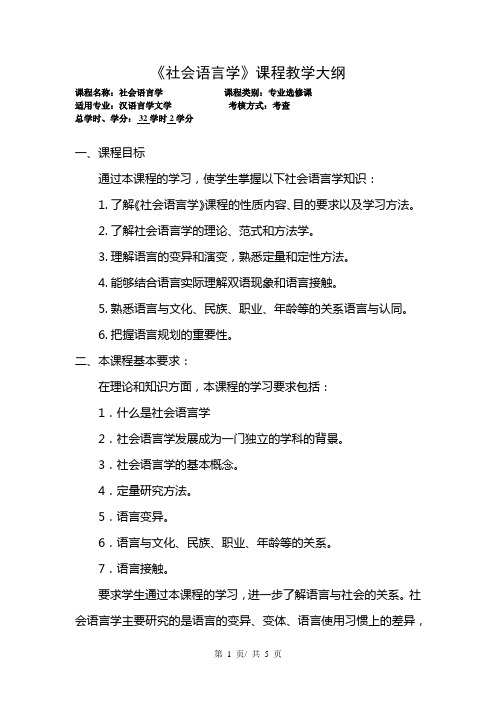
《社会语言学》课程教学大纲课程名称:社会语言学课程类别:专业选修课适用专业:汉语言学文学考核方式:考查总学时、学分: 32学时 2 学分一、课程目标通过本课程的学习,使学生掌握以下社会语言学知识:1.了解《社会语言学》课程的性质内容、目的要求以及学习方法。
2.了解社会语言学的理论、范式和方法学。
3.理解语言的变异和演变,熟悉定量和定性方法。
4.能够结合语言实际理解双语现象和语言接触。
5.熟悉语言与文化、民族、职业、年龄等的关系语言与认同。
6.把握语言规划的重要性。
二、本课程基本要求:在理论和知识方面,本课程的学习要求包括:1.什么是社会语言学2.社会语言学发展成为一门独立的学科的背景。
3.社会语言学的基本概念。
4.定量研究方法。
5.语言变异。
6.语言与文化、民族、职业、年龄等的关系。
7.语言接触。
要求学生通过本课程的学习,进一步了解语言与社会的关系。
社会语言学主要研究的是语言的变异、变体、语言使用习惯上的差异,七、课程教学内容第一章什么是社会语言学(4学时)(支撑课程目标1)1.教学内容(1)社会语言学的产生;(2)社会语言学的研究对象和研究任务;(3)社会语言学的研究意义和研究价值;(4)我国社会语言学研究概况;(5)社会语言学的定量研究方法。
2.重、难点提示认识社会语言学的现实意义及应用价值,认识到作为外部语言学的社会语言学和作为内部语言学的古代汉语、现代汉语、语言学概论等课程的区别,认识到语言学与社会学、文化学、人类学及其他学科的交叉关系。
第二章语言与文化(8学时)(支撑课程目标2)1.教学内容(1)语言与文化的关系;(2)亲属称谓与亲属制度;(3)颜色词的象征意义;(4)人、店、商标、文题命名体现的文化内涵及其命名规则;(5)语言对文化的制约和影响。
2.重、难点提示语言与文化的关系;现代社会人命带来的社会问题及其解决对策;颜色词象征意义的民族性。
第三章语言与民族(6学时)(支撑课程目标4)1.教学内容(1)语言与民族的关系;(2)语言与民族感情;(3)民族语言与文化生态;(4)民族语言所反映的民族文化。
社会语言学教学大纲
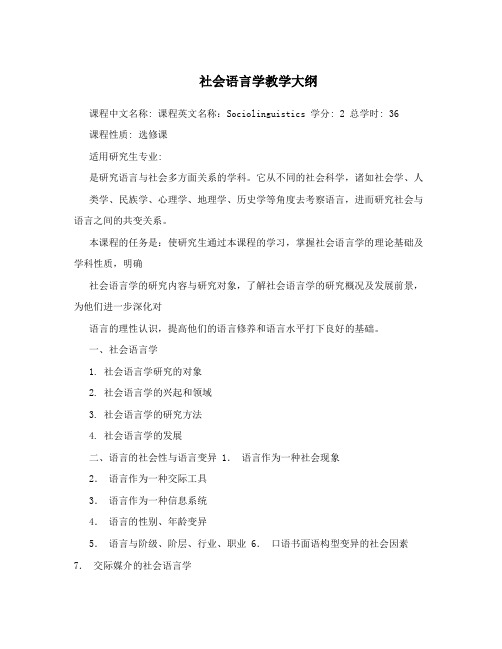
社会语言学教学大纲课程中文名称: 课程英文名称:Sociolinguistics 学分: 2 总学时: 36 课程性质: 选修课适用研究生专业:是研究语言与社会多方面关系的学科。
它从不同的社会科学,诸如社会学、人类学、民族学、心理学、地理学、历史学等角度去考察语言,进而研究社会与语言之间的共变关系。
本课程的任务是:使研究生通过本课程的学习,掌握社会语言学的理论基础及学科性质,明确社会语言学的研究内容与研究对象,了解社会语言学的研究概况及发展前景,为他们进一步深化对语言的理性认识,提高他们的语言修养和语言水平打下良好的基础。
一、社会语言学1. 社会语言学研究的对象2. 社会语言学的兴起和领域3. 社会语言学的研究方法4. 社会语言学的发展二、语言的社会性与语言变异 1.语言作为一种社会现象2.语言作为一种交际工具3.语言作为一种信息系统4.语言的性别、年龄变异5.语言与阶级、阶层、行业、职业 6.口语书面语构型变异的社会因素7.交际媒介的社会语言学8.读者与语篇及作者三、语言的文化变异1.语言与文化的关系2. 萨丕尔?沃尔夫假说3.称谓与文化4. 宗教与语言5. 塔布与委婉语词四、语言接触与语言演变1. 双语及双语制(语言社会化,双语制,双语能力,语码转换,混合语码)2. 多语制(语言忠贞性与语言更替,语言和种族,语言与政治,语言权力,洋泾浜和克里奥语,双语体现象)3. 语言演变机制4. 语言濒危五、社会语言学的应用1. 社会语言学和教育2. 语言规划和语言改革序号内容学时阅读Spolsky, Bernard. 1998. 1 社会语言学的基本概念(Introduction)3 Sociolinguistics. Oxford UniversityPress.Coulmas, Florian. S,2001. The语言的社会性与语言变异(Sociology of language Handbook of Sociolinguistics. 2 14 Foreign Language Teaching and and language variety)Research Press戴庆夏. 社会语言学概论[M]. 商3 语言的文化变异(Cultural variety of language)9 务印书馆,2004年版.Wardhaugh, Ronald. 1998.语言接触与语言演变(Language contact and Introduction to Sociolinguistics. 3rd 4 6language change) edition. Oxford: Blackwell.赵蓉晖编. 社会语言学[C]. 上海外5 社会语言学的应用(Applied sociolinguistics) 4 语教育出版社,2005年版. 1、先修课程:语言学、应用语言学2、教学方法建议:(1)本课程是理论课,以教师讲授为主,学生讨论为辅;但在呈现新内容时可以采用综合法,在启发学生提供例子的基础上概括理论;(2)课前布置查阅或收集实例的作业,使得学生在课堂讨论时有言可发;(3)教师在讲解过程中应多举例,基本上英文讲授,并尽量运用多媒体教学手段辅助教学;(4)每讲一章后,学生就讲授内容中的重点书面回答一两个问题,作为本课程成绩的依据之一。
《社会语言学》课程教案

社会语言学在教育领域中的应用
指导语言教学
社会语言学可以指导语言教学,帮助教师更好地理解学生的语言 习得过程,提供有效的教学方法和策略。
培养学生的语言意识
通过学习社会语言学,学生可以更加自觉地关注语言的使用和变化, 培养对语言的敏感性和批判性思维能力。
包括语言地位规划、语言教育规划、语言传播规划、语言 服务规划等。
包括调查研究、制定规划、宣传推广、实施评估等。
语言规划的评价标准与意义
评价标准
包括科学性、系统性、可行性、效果性等。
意义
对于促进语言发展、维护语言多样性、提高语言交流效率、增强国家文化软实力等方面 具有重要意义。
06 社会语言学在实际生活中 的应用
语言使用的场合与功能
不同场合的语言使用
人们在不同的场合会使用不同的语言,如在正式场合使用正式语言,在非正式 场合使用非正式语言。
语言的功能
语言具有多种功能,如交际功能、表达功能、认知功能等。人们在不同的场合 使用语言时,会根据需要选择不同的语言功能。
语言使用中的性别差异
词汇选择
男性和女性在词汇选择上可能存 在差异,如女性可能更倾向于使
研究意义
社会语言学的研究有助于我们更好地理解语言在社会中的作用和影响,为语言规划、语言教育、跨文化交际等领 域提供理论支持和实践指导。同时,社会语言学也促进了语言学与其他学科的交叉融合,推动了语言学理论的创 新和发展。
03 语言变异与语言使用
语言变异的定义与类型
定义
语言变异是指语言在使用过程中,由于各种因素的影响而产生的语言形式或使用上的差异。
《社会语言学》课件

社会语言学与其他语言学分支的关系
语音学
研究的是音的结构和音位、音素的分析和 音变过程,是对语音层面进行的学科研究。
词汇学
研究词汇和词的结构,其中也有一部分是 有关词的功能,如词类和句法等。
句法学
研究句子的基本成分、结构和组织规律, 以及句子与其他语言要素的关系。
语义学
研究语言符号的意义体系和语境下意义的 传达方式,还包括语义变化及其原因的研 究。
社会语言学的应用
社会语言学的一大应用领域是语言教学和语言规范的制定。在企业和商业领 域中,社会语言学的应用广泛,尤其是在市场营销等方面。
结论和展望
社会语言学自从上个世纪70年代以来快速发展,现在已经成为语言学中盛行的主流学门。我们期 待在更多领域和方向上研究社会语言学的贡献。
分析表情符号在社交互动中扮演的角色和意 义。
语言和身份
研究语言对身份认同和建构的影响,包括了 种族、地域、性、性取向等多个方面。
语码转换
研究多语言环境下的语码转换现象,反映了 语言使用者的个人经验和社会地位等多个方 面。
对话分析
研究人类社交对话的组织形式、话语闭合和 多样性等方面,也是社会语言学中热门的点 之一。
社会语言学的研究方法
观察
利用记录和分析自然语料库中的语言数据来发 现社会语言学规律和现象。
访谈
采用听取或录音的方式对人类语言进行评价、 描述和分析。
调查
通过问卷调查等方式采集语言使用情况和认知 数据。
语料库分析
对大量的语料进行计算机统计和分析,揭示语 言的统计规律和模式。
社会语言学的热门领域
表情符号
语言多样性ห้องสมุดไป่ตู้
研究社会和文化因素对语言多样性的影响,包 括方言、行话和异化等。
社会语言学概论教学大纲
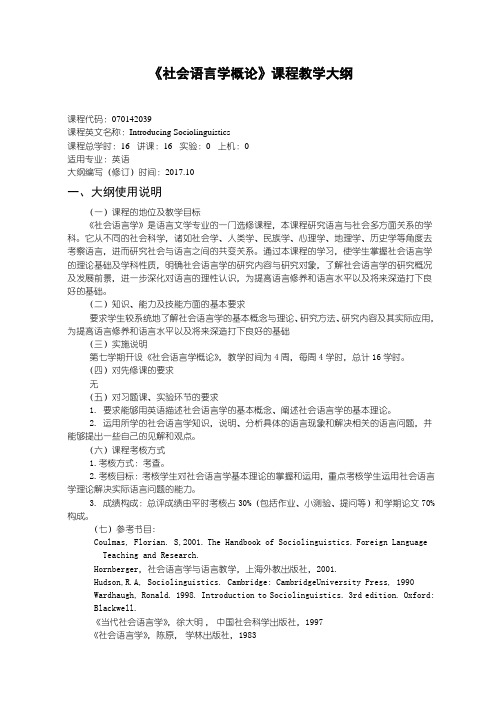
《社会语言学概论》课程教学大纲课程代码:070142039课程英文名称:Introducing Sociolinguistics课程总学时:16 讲课:16 实验:0 上机:0适用专业:英语大纲编写(修订)时间:2017.10一、大纲使用说明(一)课程的地位及教学目标《社会语言学》是语言文学专业的一门选修课程,本课程研究语言与社会多方面关系的学科。
它从不同的社会科学,诸如社会学、人类学、民族学、心理学、地理学、历史学等角度去考察语言,进而研究社会与语言之间的共变关系。
通过本课程的学习,使学生掌握社会语言学的理论基础及学科性质,明确社会语言学的研究内容与研究对象,了解社会语言学的研究概况及发展前景,进一步深化对语言的理性认识,为提高语言修养和语言水平以及将来深造打下良好的基础。
(二)知识、能力及技能方面的基本要求要求学生较系统地了解社会语言学的基本概念与理论、研究方法、研究内容及其实际应用,为提高语言修养和语言水平以及将来深造打下良好的基础(三)实施说明第七学期开设《社会语言学概论》,教学时间为4周,每周4学时,总计16学时。
(四)对先修课的要求无(五)对习题课、实验环节的要求1. 要求能够用英语描述社会语言学的基本概念、阐述社会语言学的基本理论。
2. 运用所学的社会语言学知识,说明、分析具体的语言现象和解决相关的语言问题,并能够提出一些自己的见解和观点。
(六)课程考核方式1.考核方式:考查。
2.考核目标:考核学生对社会语言学基本理论的掌握和运用,重点考核学生运用社会语言学理论解决实际语言问题的能力。
3. 成绩构成:总评成绩由平时考核占30%(包括作业、小测验、提问等)和学期论文70%构成。
(七)参考书目:Coulmas, Florian. S,2001.The Handbook of Sociolinguistics.Foreign Language Teaching and Research.Hornberger,社会语言学与语言教学,上海外教出版社,2001.Hudson,R.A, Sociolinguistics. Cambridge: CambridgeUniversity Press, 1990Wardhaugh, Ronald. 1998. Introduction to Sociolinguistics. 3rd edition. Oxford: Blackwell.《当代社会语言学》,徐大明,中国社会科学出版社,1997《社会语言学》,陈原,学林出版社,1983《社会语言学》,赵蓉晖编.上海外语教育出版社,2005《社会语言学概论》,戴庆夏,商务印书馆,2004二、中文摘要《社会语言学》是语言文学专业的一门选修课程,是研究语言与社会多方面关系的一门学科。
《社会语言学》课程教案

performanc sociolinguistical e of rules approach
乔姆斯基的理想说话人和听话人
Linguistic theory is concerned primarily with an ideal speaker/listener, in a completely homogeneous speechcommunity, who knows his language perfectly and is unaffected by such grammatically irrelevant conditions as memory limitations, distractions, shifts of attention and interest, and errors (random or characteristic) in applying his knowledge of the language in actual performance. --Chomsky (1965) Aspects of the Theory of Syntax
课时安排
周 10 11 12 13 14 15 16 17 日期 内容 语言的社会变异——阶层与职业 语言的社会变异——年龄与性别 语体风格学 语言接触——借词 语言接触——双语双方言 语言接触——混合语、语言消亡 中国语言规划 外国语言规划
18
讨论课二
考核方式
比例 平时1 共计50% 平时2 平时3 讨论课1 讨论课2 平时作业
孤峰
台地
地貌类型图
冰碛
支流
群岛from 海湾 地峡
沙洲
SocioLinguistics@whu
社会分层
《社会语言学》课程教学大纲经典版.doc
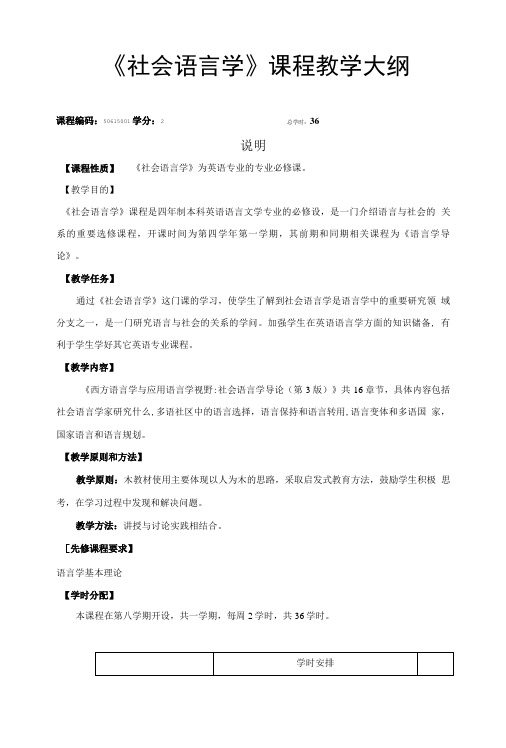
《社会语言学》课程教学大纲课程编码:50615001学分:2 总学时:36说明【课程性质】《社会语言学》为英语专业的专业必修课。
【教学目的】《社会语言学》课程是四年制本科英语语言文学专业的必修设,是一门介绍语言与社会的关系的重要选修课程,开课时间为第四学年第一学期,其前期和同期相关课程为《语言学导论》。
【教学任务】通过《社会语言学》这门课的学习,使学生了解到社会语言学是语言学中的重要研究领域分支之一,是一门研究语言与社会的关系的学问。
加强学生在英语语言学方面的知识储备, 有利于学生学好其它英语专业课程。
【教学内容】《西方语言学与应用语言学视野:社会语言学导论(第3版)》共16章节,具体内容包括社会语言学家研究什么,多语社区中的语言选择,语言保持和语言转用,语言变体和多语国家,国家语言和语言规划。
【教学原则和方法】教学原则:木教材使用主要体现以人为木的思路,采取启发式教育方法,鼓励学生积极思考,在学习过程中发现和解决问题。
教学方法:讲授与讨论实践相结合。
[先修课程要求】语言学基本理论【学时分配】本课程在第八学期开设,共一学期,每周2学时,共36学时。
【教材及必要参考书】教材:《社会语言学导论》,Janet Holmes,世界图书出版公司,2011年,第三版。
参考书:[1]《社会语言学引论》,Ronald Wardhaugh,外语教学与研究版社,2000。
[2]Sociolinguistics, Hudson R.A.,Beijing: Foreign Language Teaching and ResearchPress ,2(X)0.[3]《社会语言学论文集》,祝腕瑾,北京大学出版社,1985。
大纲内容第一部分社会语言学概述【教学目的和要求】教学目的:了解社会语言学的基本理论。
教学要求:掌握社会语言学的基木理论。
【内容提要】第一节一、社会语言学家研究什么?二、何为社会语言学家?三、为什么我们用不同的方法表达同样的事情?四、我们表达事情的不同方法有哪些?五、社会因素、范畴和解释六、A部分多语社区【教学重点与难点问题】教学重点:社会语言学家研究范畴教学难点:社会因素、范畴和解释【复习思考题】1.如何结束语言变异?第二部分多语社区中的语言选择【教学目的和要求】教学目的:多语社区中的语言选择教学要求:掌握语言选择。
社会语言学教程
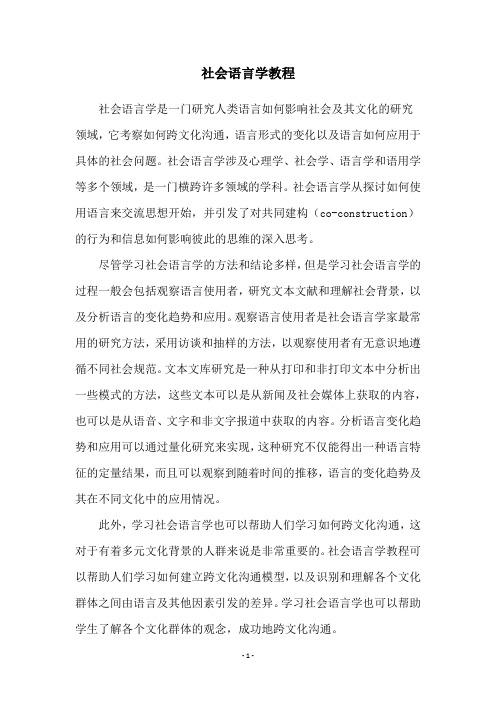
社会语言学教程社会语言学是一门研究人类语言如何影响社会及其文化的研究领域,它考察如何跨文化沟通,语言形式的变化以及语言如何应用于具体的社会问题。
社会语言学涉及心理学、社会学、语言学和语用学等多个领域,是一门横跨许多领域的学科。
社会语言学从探讨如何使用语言来交流思想开始,并引发了对共同建构(co-construction)的行为和信息如何影响彼此的思维的深入思考。
尽管学习社会语言学的方法和结论多样,但是学习社会语言学的过程一般会包括观察语言使用者,研究文本文献和理解社会背景,以及分析语言的变化趋势和应用。
观察语言使用者是社会语言学家最常用的研究方法,采用访谈和抽样的方法,以观察使用者有无意识地遵循不同社会规范。
文本文库研究是一种从打印和非打印文本中分析出一些模式的方法,这些文本可以是从新闻及社会媒体上获取的内容,也可以是从语音、文字和非文字报道中获取的内容。
分析语言变化趋势和应用可以通过量化研究来实现,这种研究不仅能得出一种语言特征的定量结果,而且可以观察到随着时间的推移,语言的变化趋势及其在不同文化中的应用情况。
此外,学习社会语言学也可以帮助人们学习如何跨文化沟通,这对于有着多元文化背景的人群来说是非常重要的。
社会语言学教程可以帮助人们学习如何建立跨文化沟通模型,以及识别和理解各个文化群体之间由语言及其他因素引发的差异。
学习社会语言学也可以帮助学生了解各个文化群体的观念,成功地跨文化沟通。
社会语言学的应用不仅可以拓展人们的文化知识,而且可以帮助解决社会上的一些棘手问题。
比如,当一个地区或者一个国家出现多元文化背景时,社会语言学可以帮助人们理解和解决文化差异带来的挑战。
另外,社会语言学也可以帮助当事者理解他们所处社会中语言在形成社会共识方面所起到的重要作用。
社会语言学是一门应用丰富的学科,一门应用广泛的学科。
它可以帮助人们更好地理解和参与社会环境,帮助人们学习如何沟通,跨越文化的沟通桥梁,以及解决社会问题。
社会语言学 教学大纲
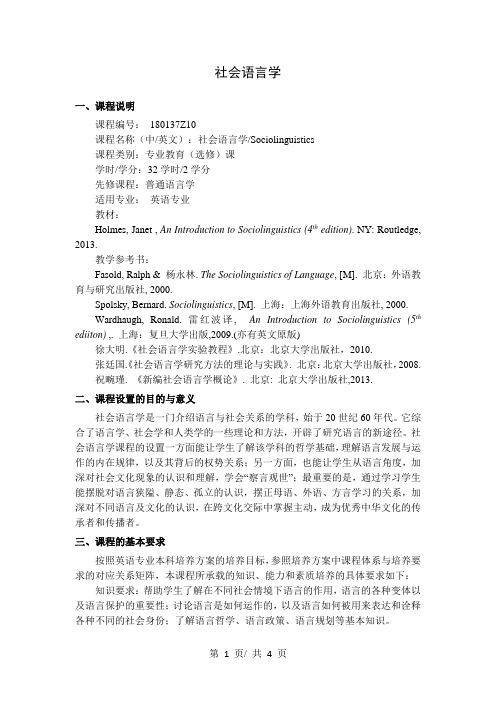
社会语言学一、课程说明课程编号:180137Z10课程名称(中/英文):社会语言学/Sociolinguistics课程类别:专业教育(选修)课学时/学分:32学时/2学分先修课程:普通语言学适用专业:英语专业教材:Holmes, Janet, An Introduction to Sociolinguistics (4th edition). NY: Routledge, 2013.教学参考书:Fasold, Ralph & 杨永林. The Sociolinguistics of Language,[M]. 北京:外语教育与研究出版社, 2000.Spolsky, Bernard. Sociolinguistics, [M]. 上海:上海外语教育出版社, 2000.Wardhaugh, Ronald. 雷红波译, An Introduction to Sociolinguistics (5th ediiton) ,. 上海:复旦大学出版,2009.(亦有英文原版)徐大明.《社会语言学实验教程》.北京:北京大学出版社,2010.张廷国.《社会语言学研究方法的理论与实践》. 北京:北京大学出版社,2008.祝畹瑾. 《新编社会语言学概论》. 北京: 北京大学出版社,2013.二、课程设置的目的与意义社会语言学是一门介绍语言与社会关系的学科,始于20世纪60年代。
它综合了语言学、社会学和人类学的一些理论和方法,开辟了研究语言的新途径。
社会语言学课程的设置一方面能让学生了解该学科的哲学基础,理解语言发展与运作的内在规律,以及其背后的权势关系;另一方面,也能让学生从语言角度,加深对社会文化现象的认识和理解,学会“察言观世”;最重要的是,通过学习学生能摆脱对语言狭隘、静态、孤立的认识,摆正母语、外语、方言学习的关系,加深对不同语言及文化的认识,在跨文化交际中掌握主动,成为优秀中华文化的传承者和传播者。
《社会语言学》课程教案

CEPA(Closer Economic Partnership Arrangement): 关于建立更紧密经贸关系的安排
BRT(Bus Rapid Transit):快速公交系统 ETC(Electronic Toll Collection):电子不停车收费系统
音译+上位标记 Thailand泰国、Guam关岛、Laos寮国(台)、beer啤酒、 card卡片
(完全意译)
史有为(2000)p117
史有为(2000)p117
史有为(2000)p117
商标语言
类别 食品饮料 日化 汽车 零售业 IT业
其他
英语
汉译
Coca-cola
可口可乐
Procter & Gamble
宝洁(粤语)
Lexus
凌志(雷克萨斯)
法Carrefour(岔路口) 家乐福
Hewlett-Packard
惠普
Pentium
奔腾
Unilever
联合利华
思考:药名
史有为(2000)
语音、语法的借用
语音的借用必须以词汇为载体 音位的借用 音位配列的借用 句法层面的借用最困难,形态层面相对容易 词缀的借用【意译】,反(anti-)、后(post-)、
借用的策略:义【一定】,音?形? 从文字体系上看 从语言结构上看
借用的前途
完全意译、音义兼表:逐渐融入汉语 借形:字母词的前途未卜,会不会像日语那样造
出一套类似片假名的中式字母,或者恢复注音符 号? 如果连基本词汇都开始借用?
汉语词汇借用模式图
时代
主要来源
社会语言学讲稿1

美 国 社 会 语 言 学 家 罗 杰 ·夏 伊 (Roger W.Shuy,1975)曾经这样写道:
百科全书》在“语言学”条目下也有一小节专门讲
到社会语言学。
第一次社会语言学的会议是于1964年在
美国格杉矶加利福尼亚大学召开的。同年, 美国印第安那州立大学语言学院又召开了另 一次社会语言学家的讨论会。因此可以说, 1964年标志着一门新的学科开始有计划的传 播,是语言研究的一个转折点。
1966年,布莱特(W.Bright)将1964年社会语言学讨 论会论文汇编成册出版。这便是最早的社会语言学 论文汇编(Sociolinguistic: Proceedings of the UCLA Sociolinguistics Conference , 1964 , The Hague : Mouton)。这本论文汇编反映出当时社会语言学研究 的七个方面:(1)说话者的社会身分;(2)与交际过程 有关的听话者的身分;(3)言语事件发生的社会环境; (4)社会方言的历时和共时分析;(5)说话者对言语行 为形式的不同社会估价;(6)语言变异的程度;(7)社 会语言学研究的实际应用。我们可以从这里看到当 时社会语言学的研究范围。
中国出版的《语言学百科词典》(上海辞书出 版社1993年出版)这样定义社会语言学:
“运用语言学和社会学等学科的理论和方法,联系社会研究语言 现象的一门新兴边缘学科。前者包括语言社会本质的特点和规律、语言 内部规律和外部规律的相互关系和作用、民族语言和民族形成的 关系、民族共同语的形成和社会发展的关系、语言演变和社会演 变的关系等问题。后者包括语言的地域变体、社会变体、双语和 多语现象、不同言语环境中的语言变体等问题,其目的是揭示社 会结构变异和语言结构变异之间的系统对应关系及相互的因果关 系。此外社会语言学研究还为一个国家或民族的标准语的确定或 选择、文字的制定和改革、语言政策的制定、语言规划的拟定、 语言教学及其研究,提供依据和指导!” “研究方法主要采用实地调查、数学分析、对比研究和实验 定量定性分析。”
《社会语言学》课程教学大纲
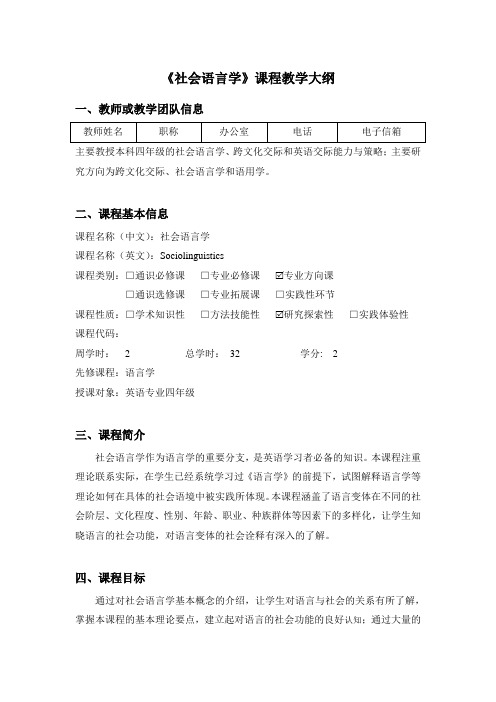
《社会语言学》课程教学大纲一、教师或教学团队信息主要教授本科四年级的社会语言学、跨文化交际和英语交际能力与策略;主要研究方向为跨文化交际、社会语言学和语用学。
二、课程基本信息课程名称(中文):社会语言学课程名称(英文):Sociolinguistics课程类别:□通识必修课□专业必修课 专业方向课□通识选修课□专业拓展课□实践性环节课程性质:□学术知识性□方法技能性 研究探索性□实践体验性课程代码:周学时: 2 总学时:32 学分: 2先修课程:语言学授课对象:英语专业四年级三、课程简介社会语言学作为语言学的重要分支,是英语学习者必备的知识。
本课程注重理论联系实际,在学生已经系统学习过《语言学》的前提下,试图解释语言学等理论如何在具体的社会语境中被实践所体现。
本课程涵盖了语言变体在不同的社会阶层、文化程度、性别、年龄、职业、种族群体等因素下的多样化,让学生知晓语言的社会功能,对语言变体的社会诠释有深入的了解。
四、课程目标通过对社会语言学基本概念的介绍,让学生对语言与社会的关系有所了解,掌握本课程的基本理论要点,建立起对语言的社会功能的良好认知;通过大量的实际生活案例,使学生知晓语言变体在不同的社会语境因素下的多样化;课内和课外进行大量的实证研究,鼓励学生接触实际生活的案例,以理论联系实际的方式,让学生对语言与社会的密切关系有更深刻的感性认识。
五、教学内容与进度安排课程教学过程中,以教师的讲授和指导以及学生的阅读、讨论、探究、和实践为主要的课内教学环节,以学生的课前预习、课后复习、问题回答准备和学期研究项目等为主要的课外环节,整个教学过程贯穿师生的互动。
六、修读要求修读本课程的学生必须参加每次的课堂讨论、辩论、和学期研究项目,无故缺席两次,最终评分时扣10分。
学生按照作业要求完成每次口头和笔头作业,对引用他人观点必须注明出处,如有发现抄袭行为,也将影响最终的评估。
要求学生通过修读本次课程,培养独立思考和批判性思维等高阶认知能力,做到独立发表自己的观点,并能结合学到的相关理论进行较深层次的分析,充分展现出对于语言变体社会诠释的感知和理解。
大班语言社会课程设计
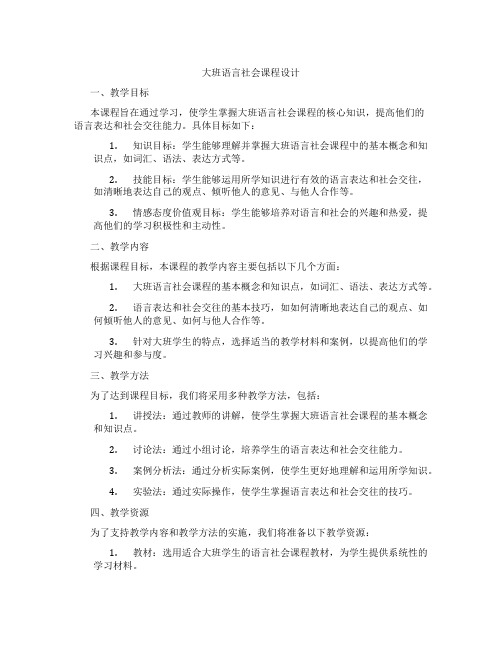
大班语言社会课程设计一、教学目标本课程旨在通过学习,使学生掌握大班语言社会课程的核心知识,提高他们的语言表达和社会交往能力。
具体目标如下:1.知识目标:学生能够理解并掌握大班语言社会课程中的基本概念和知识点,如词汇、语法、表达方式等。
2.技能目标:学生能够运用所学知识进行有效的语言表达和社会交往,如清晰地表达自己的观点、倾听他人的意见、与他人合作等。
3.情感态度价值观目标:学生能够培养对语言和社会的兴趣和热爱,提高他们的学习积极性和主动性。
二、教学内容根据课程目标,本课程的教学内容主要包括以下几个方面:1.大班语言社会课程的基本概念和知识点,如词汇、语法、表达方式等。
2.语言表达和社会交往的基本技巧,如如何清晰地表达自己的观点、如何倾听他人的意见、如何与他人合作等。
3.针对大班学生的特点,选择适当的教学材料和案例,以提高他们的学习兴趣和参与度。
三、教学方法为了达到课程目标,我们将采用多种教学方法,包括:1.讲授法:通过教师的讲解,使学生掌握大班语言社会课程的基本概念和知识点。
2.讨论法:通过小组讨论,培养学生的语言表达和社会交往能力。
3.案例分析法:通过分析实际案例,使学生更好地理解和运用所学知识。
4.实验法:通过实际操作,使学生掌握语言表达和社会交往的技巧。
四、教学资源为了支持教学内容和教学方法的实施,我们将准备以下教学资源:1.教材:选用适合大班学生的语言社会课程教材,为学生提供系统性的学习材料。
2.参考书:提供相关的参考书籍,丰富学生的知识储备。
3.多媒体资料:利用多媒体课件、视频等资源,增加课堂的趣味性和互动性。
4.实验设备:准备必要的实验设备,让学生在实际操作中掌握相关技巧。
五、教学评估为了全面、客观地评估学生的学习成果,我们将采取以下评估方式:1.平时表现:通过观察学生在课堂上的参与程度、提问回答等情况,评估他们的学习态度和积极性。
2.作业:布置适量的作业,评估学生对课程知识的理解和运用能力。
社会语言学课程讲义

社会语言学讲义周玉蓉参考书目:1、徐大明、陶红印、谢天蔚,《当代社会语言学》,北京:中国社会科学出版社,1997。
2、祝畹瑾,《社会语言学概论》,长沙:湖南教育出版社,1992。
3、祝畹瑾,《社会语言学译文集》,北京:北京大学出版社,1985。
4、陈松岑,《社会语言学导论》,北京:北京大学出版社,1985。
5、真田信治、涩谷胜己、阵内正敬、杉户清树著,王素梅、彭国跃译,《社会语言学概论》,上海:上海译文出版社,2002。
6、戴庆厦,《社会语言学教程》,北京:中央民族大学出版社,1993。
7、王德春、孙汝建、姚远,《社会心理语言学》,上海:上海外语教育出版社,1995。
8、Hudson ,R,A,Sociolinguistics . Cambridge: Cambridge University Press, 1980年。
9、刊物:《国外语言学》引言语言是什么一、语言的定义语言是什么——语言研究的理论、语言研究的目标、语言研究的范围、语言研究的范围、语言研究的途径、语言研究的方法、语言研究的重点、语言研究的结果、语言政策的制订等。
(一)语言定义例:列宁:语言是最重要的人类交际工具。
斯大林:语言是工具、手段,人们利用它来互相交际,交流思想,达到相互了解。
赵元任:语言是人跟人互通信息,用发音器官发出来的、成系统的行为方式。
《语言学纲要》:语言是人类最重要的交际工具,语言是思维工具,也是认识成果的贮存所。
《简明语言学词典》:语言是人类特有的交际工具、思维工具,也是人类特有的一种信息工具。
语言结构本身是音义结合的符号系统。
陈原:语言是一种社会现象。
语言是人类最重要的交际工具。
语言是人的思想的直接现实。
申小龙:说到底,语言不仅仅是一个交际工具或符号系统,语言本质上是一个民族的意义体系和价值体系,是一个民族的世界观。
洪堡特:从真正的本质上来看,语言是一件持久的事物,在每一个瞬间都稍纵即逝,即使通过文字保存下来的,也只是不完整的、木乃伊式的东西,只在描述当前话语时才重新需要。
- 1、下载文档前请自行甄别文档内容的完整性,平台不提供额外的编辑、内容补充、找答案等附加服务。
- 2、"仅部分预览"的文档,不可在线预览部分如存在完整性等问题,可反馈申请退款(可完整预览的文档不适用该条件!)。
- 3、如文档侵犯您的权益,请联系客服反馈,我们会尽快为您处理(人工客服工作时间:9:00-18:30)。
第三讲
粤方言的语音特点 音韵学补讲(上)
粤语的分布
中国语言地图集
粤语的分布
中国语言地图集
样本:北风与太阳
普通话 北风与太阳争吵谁的本领大,恰有路人穿着外套 经过。他们两个协商,谁能让路人脱去外套谁就 是赢家。于是,北风死命刮起风来,但是它越刮 得凶,路人把衣服裹得越紧。最终北风只好放弃。 接着,太阳热辣辣地照射起来,一会儿路人就脱 掉了衣服。最终,北风被迫承认太阳比他本领大。
鸡 浇 建
北京话
进一步学习
袁家骅(2001)汉语方言概要,第二版,粤方言 部分,北京:语文出版社 汉语方音字汇、广州方言词典的音系说明 爱问有pdf版和其他音频、视频材料
本课作业
选一首你喜欢的粤语歌,试着标注国际音标,可 以只标声母、韵母,不标声调 举例:斜阳伴晚烟 我像归鸟倦 晚霞伴我过稻田 找出主要的粤方言媒体和论坛
精组细音 (尖音)
进尖蒋借接
广州 话
北京 话
k
k
k
tcj
ts
tcj
韵母比较
用国际音标写出普通话的韵母
SocioLinguistics@whu
韵母比较
用国际音标写出普通话的声母
SocioLinguistics@whu
韵母比较
用国际音标写出普通话的声母
SocioLinguistics@whu
陽 上
上 陰 入下陰入 陽去 ( 短 陰 ( 長 陰 陽入 入) 入) 55 忽 7 (1) 33 發 8 (3) faat3 22 佛 9 (6) fat6
21/1 33 13 22 1 訓 焚 3 4 奮 5 份 6
fan fan4 fan5 fan6 fat1 3
听辨声调
丝
时
史
事
试
士
识
食
分
焚
中古
伴 淡 坐 近 並b 定d 从dz 群g
普通话
p t ts tcj
广州话
ph th tsh kh
声母的音类差异2
非组声母 溪母合口 晓母合口
分房饭福法 枯科课魁宽款 呼花灰欢婚荒 苦库况 忽虎火霍 广州 话 北京 话 f f f kh(u) f h(u)
见系洪音
姑高该官共
见系细音 (团音)
金交斤居君
粉
奋
训
份
忽
发
佛
听辨声调
声调 阴平 阳平 阴上 阳上 阴去 阳去 阴入
例子
中古 清浊 例子 中古 清浊
阳入
丝
时
史
士
试
事
识
食
船z 发 佛
心s 禅z 生s 崇z 书s 崇z 书s 分 焚 粉 愤 粪 份 忽
非f 奉v 非f 奉v 非f 奉v 晓h 非f 奉v
声母比较
用国际音标写出普通话的声母
声母的音类差异1
现代汉语方言音库
现代汉语方言音库
声母比较
广州话的声母
韵母比较
SocioLinguistics@whu
韵母比较
SocioLinguistics@whu
聲 調陰 陰 陰 陽 名稱 平 上 去 平 55/ 調值 35 53 漢 字 分 粉 舉例 代 表 1 2 數字 粵 語 fan fan 拼音 1 2
韵母比较
用国际音标写出普通话的声母
SocioLinguistics@whu
中古的四等
பைடு நூலகம்
江永:一等洪大,二等次大,三四皆细,四等尤细
一等 二等 家 街 交跤
一间
三四等
果假摄 蟹摄 效摄 山摄 宕梗摄
广州话
歌 该 高 肝 钢
北京话
广州话 北京话 广州话 北京话 广州话 北京话 广州话 硬 姜
SocioLinguistics@whu
